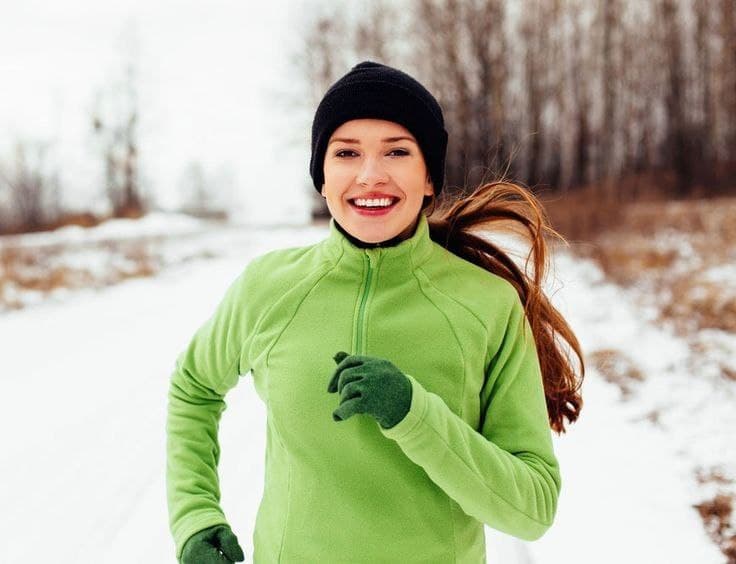Frigid temperatures can discourage even the most motivated exercisers. Without motivation, it’s easy to pack away your workout gear for the winter. But you don’t have to let cold weather spell the end of your fitness routine. First, you need to know the benefits of exercising in cold weather and keep in mind that it is worth exercising even in cold weather outdoors.
-
It strengthens your cardiovascular system
According to a study by the National Health and Nutrition Examination Survey, outdoor exercise could decrease your risk of dying from cardiovascular disease by up to 27 percent, CNN reported.
Exercising in cold weather challenges your body further and can help strengthen a healthy heart. The opposite holds for individuals with heart problems, however. Because the cold forces your heart to work harder, an unhealthy heart might struggle to pump blood through your body.
-
It boosts vitamin D and combats SAD
The shorter days of winter and lower temperatures can contribute not only to vitamin D deficiencies but also to developing seasonal affective disorder. Exercising outdoors, even if it’s just going for a walk, can serve both the vitamin and fitness boost.
Also exercising in cold weather can boost your immune system, improve your mood, burn more calories, presents new training opportunities, etc.
Try these tips for exercising during cold weather to stay fit, motivated, safe, and warm.
1. Stay safe during cold-weather exercise
Exercise is safe for almost everyone, even in cold weather. But if you have certain conditions, such as asthma, heart problems, or Raynaud’s disease, check with your doctor first to review any special precautions you need based on your condition or your medications.
2. Check weather conditions and wind chill
Check the forecast before heading outside. Temperature, wind, and moisture, along with the length of time that you’ll be outside, are key factors in planning a safe cold-weather workout.
Wind and cold together make up the wind chill, a common element in winter weather forecasts. Wind chill extremes can make exercising outdoors unsafe even with warm clothing. The wind can penetrate your clothes and remove the insulating layer of warm air that surrounds your body. Any exposed skin is vulnerable to frostbite.
If the temperature dips below zero F (minus 18 C) or the wind chill is extreme, consider taking a break or choosing an indoor exercise instead. Consider putting off your workout if it’s raining or snowing unless you have waterproof gear.
3. Know the signs of frostbite and hypothermia
Frostbite is an injury to the body that is caused by freezing. Frostbite is most common on exposed skin, such as your cheeks, nose, and ears. It can also occur on hands and feet. Early warning signs include numbness, loss of feeling, or a stinging sensation.
Immediately get out of the cold if you suspect frostbite. Slowly warm the affected area — but don’t rub it because that can damage your skin. Seek emergency care if numbness doesn’t go away.
Hypothermia is abnormally low body temperature. When exposed to cold temperatures, your body begins to lose heat faster than it can be produced.
Hypothermia signs and symptoms include:
- Intense shivering
- Slurred speech
- Loss of coordination
- Fatigue
Seek emergency help right away for possible hypothermia.
4. Dress in layers
Dressing too warmly is a big mistake when exercising in cold weather. Exercise generates a considerable amount of heat — enough to make you feel like it’s much warmer than it is. The evaporation of sweat, however, pulls heat from your body and you feel chilled.
So as a solution, dress in layers that you can remove as soon as you start to sweat and then put back on as needed. First, put on a thin layer of synthetic material, such as polypropylene, which draws sweat away from your body. Avoid cotton, which stays wet next to your skin.
Next, add a layer of fleece or wool for insulation. Top this with a waterproof, breathable outer layer. You may need to experiment to find the right combination of clothing for you based on your exercise intensity. If you’re lean, you may need more insulation than someone heavier.
5. Protect your head, hands, feet, and ears
When it’s cold, blood flow is concentrated in your body’s core, leaving your head, hands, and feet vulnerable to frostbite. Wear a thin pair of glove liners made of a wicking material (such as polypropylene) under a pair of heavier gloves or mittens lined with wool or fleece. Put on the mittens or gloves before your hands become cold and then remove the outer pair when your hands get sweaty.
Consider buying exercise shoes a half size or one size larger than usual to allow for thick thermal socks or an extra pair of regular socks. And don’t forget a hat to protect your head or a headband to protect your ears. If it’s very cold, consider wearing a scarf or ski mask to cover your face.
6. Don’t forget safety gear and sunscreen
If it’s dark when you exercise outside, wear reflective clothing. And if you ride a bike, both headlights and taillights are a good idea. To stay steady on your feet, choose footwear with enough traction to prevent falls, especially if it’s icy or snowy.
It’s as easy to get sunburned in winter as in summer — even more so if you’re exercising in the snow or at high altitudes. Wear a sunscreen that blocks both UVA and UVB rays and a lip balm with sunscreen. Protect your eyes from snow and ice glare with dark glasses or goggles.
7. Drink plenty of fluids
Don’t forget about hydration, as it’s just as important during cold weather as it is in the heat. Drink water or sports drinks before, during, and after your workout, even if you’re not thirsty.
8. Warming up to the cold
Cold muscles are at a greater risk for strains and injuries, so make sure to warm up before your cold-weather workout. “You want to avoid starting with static stretches, that is, not moving the body part while stretching, which can further increase your risk for injury,” says Dr. Adam Tenforde of Harvard’s Spaulding Rehabilitation Network.
9. Choose a safe surface
Make sure your route offers good footing and is clear and safe to navigate. Wear shoes with good traction and invest in walking poles for support and to help avoid slips and falls.
While exercising outside in the winter can be perfectly safe, it does require some extra precautions. The physiological and metabolic impact of exercising in cold weather can be intense. The body needs to work harder to perform in a harsher climate and be able to generate adequate heat to keep warm.
When the body is exposed to a significant change in temperature, elevation, or intensity, its initial need for energy increases, so it breaks down glycogen, a form of carbohydrate, in the muscles.
10. Fuel Up Consistently
The number of calories an individual burns during any exercise depends on many factors, including his or her level of physical fitness, height, weight, body composition, age, and the type of exercise. Eating a hearty meal rich in carbs and protein two-to-four hours before a workout will give your body an optimal fuel source.
“After the first hour of activity, a carbohydrate-rich snack should be consumed every 30 to 60 minutes to replete energy during exercise,” said Julie Lois, RD, CD, sports dietitian with the Froedtert & the Medical College of Wisconsin health network. For this type of snack, she recommends eating:
- a peanut butter sandwich
- orange slices
- a banana
- an energy bar
- trail mix with dried fruit
If you plan to continue exercising the same day or the next day, eat a carb-and-protein-rich snack within 30 to 60 minutes of completing your workout. This will deplete glycogen stores in the muscles and stimulate muscle repair. Recovery foods that Lois recommends include:
- low-fat chocolate milk
- a fruit and yogurt smoothie
- graham crackers with nut butter
- an apple or banana with nut butter
These tips can help you safely and enjoyably exercise when temperatures drop. Closely monitor how your body feels during cold-weather exercise to help prevent injuries such as frostbite.
In the end, consider shortening your outdoor workout or skipping it altogether during weather extremes, and know when to head home and warm up. Also, be sure to let someone know your exercise route and your expected return time, in case something does go wrong.

